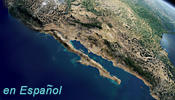![[Ocean Oasis Conservation]](images/bnr-conservation.gif)

![[Ocean Oasis Conservation]](images/bnr-conservation.gif) |  |
|
|
In 1995 Italian investors proposed to build a hotel on Isla Coronado, a small island (850 hectares) situated 11 km north of Loreto. As this island is part of the Islas del Golfo protected area, the project required an environmental impact statement (EIS). The hotel of 40 rooms was designed to have all the technological advances: solar panels for water heating, sewage treatment, water desalinating plant, and careful management of solid waste. The project was presented by the proponents as a viable alternative for the protection of the island with low impact tourism and a research station to be built next to the hotel that would monitor the island and provide guidelines for a conservationist management of the island (Anonymous 1995). The project was strongly challenged by local and national conservation and citizen groups, and was finally abandoned. The process, however, offers an interesting example of the attraction islands produce for exclusive tourism and of the rationale used to justify their development. It is also a prime example of the problems, conflicts of interest, and dangers for island conservation that can be caused by lack of clear governmental policies. The main argument used by the developers was the the limited conservation and management actions that were in place on Coronado despite its legal protection since 1978. The presence of introduced animals (cats and sheep) and the high levels of human use by fishermen and tourists were used as strong arguments to propose that the research station, to be sponsored by the hotel and managed by the state university, was the only and best option to protect the island and ameliorate its deteriorated ecological status. The probable, but not yet certain, extinction of the endemic pack rat of Coronado (Neotoma bunkeri) due to 30 years of cat predation was another argument used to support the claim that the island was disturbed and could be developed. However, most of the opponents to the project argued that once the island is connected to the coast by means of daily transport of food, personnel, tourists, baggage, people, machinery, trash, etc., it is almost impossible to ensure that no exotic animals or weedy plants will reach the island. Coronado Island is now part of the Parque Nacional Bahía de Loreto (Loreto Bay National Park) and it is legally more protected than it was before. The introduced species are being erradicated successfully (Arnaud 1998). However, there are ongoing development plans and growing pressures to develop other gulf islands for tourism. The same arguments brandished for Coronado, namely, that protection in the island was not being enforced and that an "environmentally minded" development could protect the island better, are being used in other development proposals in the Sea of Cortés.
Continue to |
|
Text adapted from the conservation chapter of the book Island Biogeography in the Sea of Cortés, a forthcoming volume edited by Ted Case, Martin Cody, and Exequiel Ezcurra. The chapter was authored by Luis Bourillon, Antonio Cantú, Exequiel Ezcurra, María Elena Martínez, and Alejandro Robles. |
Conservation | Site Index | Ocean Oasis
San Diego Natural History Museum & PRONATURA
© 2000 CinemaCorp of the Californias